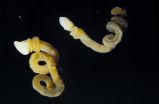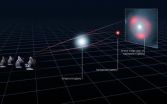(Press-News.org) HOUSTON -- (March 13, 2013) – Few things in life are inevitable – death, taxes, and, if you live long enough, osteoarthritis.
No treatment will stop or significantly slow the disease, and joint replacement is the only definitive treatment. That may change, however, as researchers such as Dr. Brendan Lee (http://www.bcm.edu/genetics/index.cfm?pmid=10940), professor of molecular and human genetics at Baylor College of Medicine (http://www.bcm.edu), and his colleagues unravel the effects of a naturally occurring protein called lubricin or Proteoglycans 4 that appears to protect against the age as well as post-injury related changes. A report on their research appears online in the journal Science Translational Medicine (http://stm.sciencemag.org/).
"This protein also affects the metabolism of the cartilage and does it in a way that prevents its breakdown," said Lee, who is also director of the Rolanette and Berdon Lawrence Bone Disease Program of Texas (http://www.bcm.edu/about/gateways/bonedisease.cfm) and a Howard Hughes Medical Institute Investigator. "This is not just lubrication of the joints."
Osteoarthritis is common, affects more than 70 percent of the population between the ages of 55 and 77, and its prevalence is increasing worldwide. In most cases, treatment addresses only the symptoms. If the disease gets severe enough, surgeons replace the affected joint.
"In spite of a lot of investment, there is no disease-modifying treatment that affects the course of the disease," said Lee.
Studying osteoarthritis is difficult. Only after graduate student Merry Z.C. Ruan, in Lee's laboratory, developed a special imaging technique called phase contrast ultra-high resolution micro-computed tomography (micro-CT) that allowed her, Lee and their colleagues to not only "see" the tiny cartilage in the knee joint but to also quantify that amount in the mouse joint, were they able to effectively apply the power of mouse genetics to their research.
To identify new targets for treating osteoarthritis, they focused on a genetic disease in which the disorder starts early in children-- camptodactyly-arthropathy-coxa vara. These individuals are deficient in lubricin for, the protein in their joints made by special cells in the joint cartilage as well as by the cells that line part of the joint (synovial lining).
Lee asked, "If a deficiency in lubricin hastens osteoarthritis, can higher levels protect against it?"
When he and his colleagues studied mice that produced higher levels of the protein in cartilage, they found first that the animals acted and grew normally, suggesting that increased amounts of this protein was not harmful. However, mice with an injury to their knees did not develop traumatic or injury-induced osteoarthritis.
Using the specially developed microscopy technique in these mice with high levels of lubricin, Lee and his colleagues determined that the mice did not have cartilage changes usually associated with osteoarthritis.
As the mice that made extra lubricin aged, their cartilage resembled that of young mice, he said. There was no osteoarthritis suggesting that this protein may protect against the two common forms of OA- injury-related and age-related.
Eventually, Lee and Ruan tried a gene therapy on normal mice, using a specially developed virus to inject the gene into the joints of the mice. The viral vector was an engineered adenovirus that did not cause disease but spread the gene throughout the joint.
"The lubricin protein was expressed for the life of the mouse after a single injection into the joint," said Lee. Moreover, the injection similarly protected the mouse against the development of injury-related OA.
He and his colleagues plan to test the gene therapy in large animals, such as horses, that suffer from osteoarthritis similar to in humans. If it is effective in horses, the next step would be to test it in humans.
The most immediate use would probably be to treat osteoarthritis that occurs after a sports- or work-related injury.
"How can you explain this dramatic effect?" said Lee.
Using a special "chip" or microarray panel, they found that the protein not only lubricated the joint, it also affected metabolism and prevented breakdown of cartilage in the joint.
"What else do we need to do to fix osteoarthritis?" said Lee. Sometimes, stopping the destruction is not enough. Eventually, he would like to find ways to regenerate the joint cartilage.
Lee credited Ruan with much of the work that made the findings possible.
###
Others who took part include Ayelet Erez, Kilian Guse, Brian Dawson, Terry Bertin, Yuqing Chen, Ming-Ming Jiang, Jason Yustein and Francis Gannon, all of BCM.
Funding for this work came from BCM Intellectual and Developmental Disability Research Center (Grant 5P30HD024064) from the Eunice Kennedy Shriver National Institute of Child Health & Human Development, the National Institutes of Health (HD24064) and the Howard Hughes Medical Institute and the DFG, the Deutsche Forschungsgemeinschaft.
Glenna Picton
http://www.bcm.edu/news
Protein may alter inevitability of osteoarthritis
2013-03-14
ELSE PRESS RELEASES FROM THIS DATE:
Sex at zero gravity
2013-03-14
University of Montreal researchers found that changes in gravity affect the reproductive process in plants. Gravity modulates traffic on the intracellular "highways" that ensure the growth and functionality of the male reproductive organ in plants, the pollen tube. "Just like during human reproduction, the sperm cells in plants are delivered to the egg by a cylindrical tool. Unlike the delivery tool in animals, the device used during plant sex consists of a single cell, and only two sperm cells are discharged during each delivery event," explained Professor Anja Geitmann ...
Vitamin D supplements may help African Americans lower blood pressure
2013-03-14
Vitamin D supplements significantly reduced blood pressure in the first large controlled study of African-Americans, researchers report in the American Heart Association journal Hypertension.
In the prospective trial, a three-month regimen of daily vitamin D increased circulating blood levels of vitamin D and resulted in a decrease in systolic blood pressure ranging from .7 to four mmHg (depending upon the dose given), compared with no change in participants who received a placebo.
Systolic blood pressure, the top and highest number in a reading, is pressure in the arteries ...
Feynman's double-slit experiment brought to life
2013-03-14
The precise methodology of Richard Feynman's famous double-slit thought-experiment – a cornerstone of quantum mechanics that showed how electrons behave as both a particle and a wave – has been followed in full for the very first time.
Although the particle-wave duality of electrons has been demonstrated in a number of different ways since Feynman popularised the idea in 1965, none of the experiments have managed to fully replicate the methodology set out in Volume 3 of Feynman's famous Lectures on Physics.
"The technology to do this experiment has been around for about ...
No attention-boosting drugs for healthy kids, doctors urge
2013-03-14
Doctors at Yale School of Medicine and the American Academy of Neurology (AAN) have called upon their fellow physicians to limit or end the practice of prescribing memory-enhancing drugs to healthy children whose brains are still developing. Their position statement is published in the March 13 online issue of the journal Neurology, the medical journal of the AAN.
The statement was written to address the growing trend in which teens use "study drugs" before tests and parents request attention deficit hyperactivity disorder (ADHD) drugs for children who don't meet the ...
Strange phallus-shaped creature provides crucial missing link
2013-03-14
This press release is available in French.
Christopher Cameron of the University of Montreal's Department of Biological Sciences and his colleagues have unearthed a major scientific discovery - a strange phallus-shaped creature they found in Canada's Burgess Shale fossil beds, located in Yoho National Park. The fossils were found in an area of shale beds that are 505 million years old.
Their study, to be published online in the journal Nature on March 13, 2013, confirms Spartobranchus tenuis is a member of the acorn worms group which are seldom-seen animals that thrive ...
Burgess Shale worm provides crucial missing link
2013-03-14
Canada's 505 million year-old Burgess Shale fossil beds, located in Yoho National Park, have yielded yet another major scientific discovery – this time with the unearthing of a strange phallus-shaped creature.
A study to be published online in the journal Nature on March 13 confirms Spartobranchus tenuis is a member of the acorn worms group which are seldom-seen animals that thrive today in the fine sands and mud of shallow and deeper waters. Acorn worms are themselves part of the hemichordates, a group of marine animals closely related to today's sea stars and sea ...
NIST mechanical micro-drum used as quantum memory
2013-03-14
BOULDER, Colo.— One of the oldest forms of computer memory is back again—but in a 21st century microscopic device designed by physicists at the National Institute of Standards and Technology (NIST) for possible use in a
quantum computer.
The NIST team has demonstrated that
information encoded as a specific point in a
traveling microwave signal—the vertical and horizontal positions of a wave pattern at a certain time—can be transferred to the mechanical beat of a micro-drum and later retrieved with 65 percent efficiency, a good figure for experimental systems like this. ...
ALMA rewrites history of Universe's stellar baby boom
2013-03-14
Observations with the Atacama Large Millimeter/submillimeter Array (ALMA) show that the most vigorous bursts of star birth in the cosmos took place much earlier than previously thought. The results are published in a set of papers to appear in the journal Nature and in the Astrophysical Journal. The research is the most recent example of the discoveries coming from the new international ALMA observatory, which celebrates its inauguration today.
The most intense bursts of star birth are thought to have occurred in the early Universe, in massive, bright galaxies. These ...
New MRI method fingerprints tissues and diseases
2013-03-14
A new method of magnetic resonance imaging (MRI) could routinely spot specific cancers, multiple sclerosis, heart disease and other maladies early, when they're most treatable, researchers at Case Western Reserve University and University Hospitals (UH) Case Medical Center suggest in the journal Nature.
Each body tissue and disease has a unique fingerprint that can be used to quickly diagnose problems, the scientists say.
By using new MRI technologies to scan for different physical properties simultaneously, the team differentiated white matter from gray matter from ...
Joslin scientists discover mechanism that regulates production of energy-burning brown fat
2013-03-14
BOSTON – March 13, 2013 – Joslin scientists have discovered a mechanism that regulates the production of brown fat, a type of fat which plays an important role in heat production and energy metabolism. The findings, which appear in the upcoming issue of Nature, may lead to new therapies that increase BAT formation to treat obesity.
Two types of fat tissue are present in humans and other mammals: white adipose tissue (WAT) or white fat, which stores fat; and brown adipose tissue (BAT) or brown fat, which burns fat to produce heat. Brown fat also metabolizes glucose and ...




